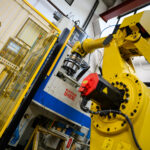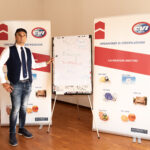Founded in Potenza with the ambitious goal of becoming a major reference point in the field of 3D computer graphics, Effenove is an all-Italian excellence that has managed to assert its leadership in a highly competitive market thanks to a strategic vision and huge investments in technological innovation. ‘Over the last ten years, we have adapted quickly to technological changes in order to keep the quality of our work high and to remain at the forefront,’ says Michele Scioscia, the company’s CEO, in this lengthy interview.

Mr Scioscia, with what mission was Effenove born?
Effenove is a cultural and creative industry in Potenza that works in the field of 3D computer graphics, interactivity, and digital museum layouts. It is an all-Italian excellence born from the desire to combine technology and cultural heritage; two worlds that we and Marica Berterame, co-founder of the company, have always found fascinating. The goal was to create experiences that could engage the public using 3D computer graphics: interactivity and digital museum displays. When we started, telling a heritage story often meant resorting to the methods of classical cinematography. In recent years, however, we have witnessed a radical transformation. Today, storytelling has become interactive, thanks to technologies such as gaming, Augmented Reality and Virtual Reality. These tools not only allow audiences to engage in new ways, but also offer the possibility to explore cultural content in a more immersive and personalised way. Examples of this type of approach are ‘Aosta Digitale, l’innovazione per la storia’ (Digital Aosta, innovation for history), which aims to tell the story of the city’s cultural heritage through Augmented Reality integrated in an interactive map for smartphones; the Parco Museo Virgilio, a multimedia museum in the Napoleonic fortress of Pietole near Mantua, in which Virgil’s works are told through interactive installations; or the Museo Archeologico Nazionale Mario Torelli in Venosa (PZ) in which the archaeological display is combined with interactive 3D models to be inspected and navigated.
One of the latest digital products produced is ‘Torre Guevara Experience’. Can you tell us about it?
The project, drafted and coordinated by Engineer Enrico Spera, head of the Building and Heritage Office of the Province of Potenza, not only recovers and enhances an urban space in the city of Potenza, but transforms it into an immersive experience for visitors by combining the physical world of architectural design with the virtual world of multimedia design in a synergic way: the visit to the large square of the Conti Guevara is enriched by a detailed historical narrative, made possible through the use of interactive technologies. One of the most fascinating is the Virtual Reality experience: users, wearing VR visors, fly over the rooftops of the city on board a ‘chronolfiera’, a hot-air balloon capable of going back in time to 1621. In that year, Countess Beatrice Guevara, a figure of great nobility of spirit, donated the land adjacent to the tower to the Capuchin friars for the construction of a place dedicated to the care of the sick and infirm. Through this experience, visitors can relive one of the most significant historical moments in the city of Potenza. Moreover, with Augmented Reality, using high-performance tablets, users can see historical buildings superimposed on the current square, creating a bridge between past and present. Finally, the ‘Torre Guevara Experience’ mobile application, which can be downloaded for free from the main stores, offers an interactive map that guides visitors through the city’s historical points of interest, making exploration more intuitive and engaging.
How much do you invest in technological innovation?
Technology underpins everything we do. Over the past ten years, we have had to redefine our production model several times to adapt to the constant changes and we have also integrated new tools using Artificial Intelligence, which have enabled us to speed up certain production steps, such as storyboarding or the creation of scenic backdrops, which used to be done by hand. These tools allow us to save precious time while maintaining a high standard of quality.
One of the biggest challenges has been to stay relevant in a rapidly changing industry. Technology advances at such a speed that it is essential to stay up-to-date. Furthermore, working with cultural heritage implies a great responsibility, as we have to ensure that the history and identity of the place is told respectfully and accurately, while using modern tools that amplify its reach.
We will continue to explore new technologies and push the boundaries of interactive storytelling. Augmented reality, virtual reality and, in the future, maybe even artificial intelligence applied to cultural heritage will be our next challenges. We will never stop innovating and looking for new ways to tell the stories of the past.
So many achievements to date. Future goals?
Our goal is to remain a benchmark in the field of digital museum displays and interactive storytelling. We want Effenove to continue to be synonymous with innovation and quality, contributing to the enhancement of cultural heritage for future generations.






















































